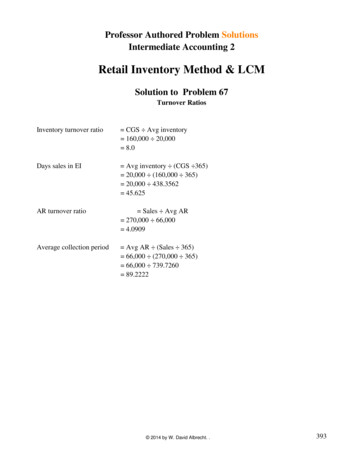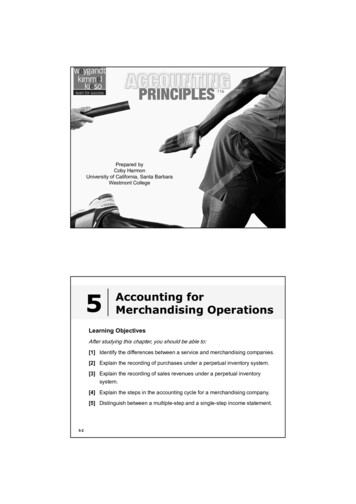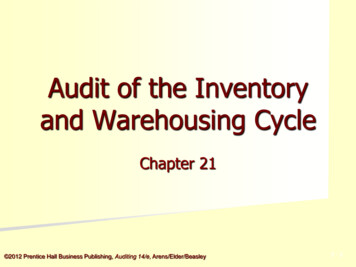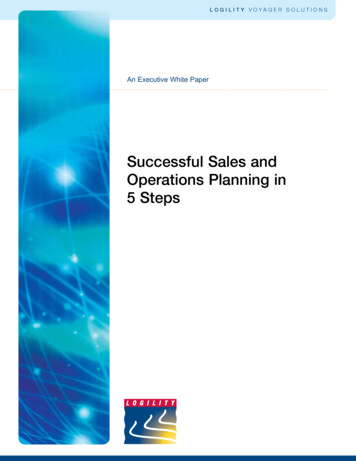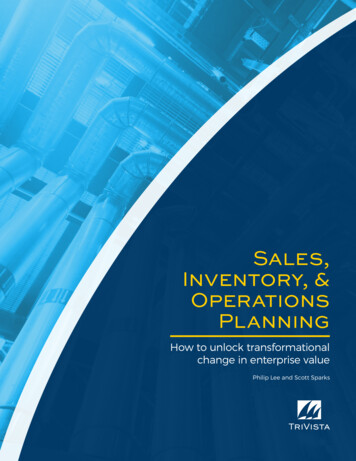
Transcription
Sales,Inventory, &OperationsPlanningHow to unlock transformationalchange in enterprise valuePhilip Lee and Scott Sparks
SIOPSales, Inventory, and OperationsPlanning is the heartbeat of everymanufacturer, distributor, andconsumer products company.SIOP is the integrating function that ties each part ofthe business’ operations together to achieve targetedfinancial outcomes. When effective SIOP processesare in place, management teams and investors knowwith confidence that revenue and margin plans can beachieved.Demand patterns, customer needs, product mix, supplier lead times, and service level requirements inevitablychange over time. Without strong SIOP processes, anyof these changes can create unpredictable operationaland financial results, and understanding how to react toget back on track can be a real challenge. SIOP providesclarity and visibility into exactly what needs to changein the operations to stay on-track and achieve targetfinancial outcomes.The value of SIOPEffective SIOP processes give clarity to exactly whichlevers in the operating model address the commonCommon issues thatcompanies withouteffective SIOP processesface when the businessenvironment inevitablychanges:“We are missing our revenue targets.We have poor or declining inventoryturns and excessive investment inworking capital.Our past due backlog continues tobuild.business issues outlined in the box to the right, andexactly how to move these levers to achieve the desiredbusiness outcomes. At a tactical level, SIOP is the process and routine used to define future demand andmost optimally balance it with supply in a consistentcadence of consensus-based review and agreement.The individual building blocks of SIOP include forecasting and demand planning, inventory planning andmanagement, capacity and capital planning, and supplyplanning (supplier order management, manufacturingproduction scheduling, and daily shop floor productionsequencing). Each of these tactical parts must be inplace and working effectively as a necessary condition2www.trivista.com Sales, Inventory, & Operations PlanningOur on-time delivery/customer serviceis below target, causing our customersto jump to the competition.Our manufacturing productivity/grossmargin is unacceptably low.Our production cannot keep upwith demand.”We want to compete for highermargin business through improvedservice levels.
to achieve this demand and supply balance. While all ofWith an integrated SIOP capability, the system respondsthis is essential, these steps alone are not sufficient forand adjusts. The individual elements of the distributionSIOP to be complete and achieve the benefits outlinedor manufacturing process consistently come togetherin Figure 1.to balance supply and demand. This routine meetingAt a strategic level, SIOP is about bringing together allrelevant inputs of future business opportunity, compe-structure and SIOP system also produce a high degreeof certainty in financial projections.tency, and each of the tactical sub-components in aCompanies that start with limited SIOP capabilitiesconsistent balancing routine that minimizes or elimi-often see substantial financial gains when an effectivenates confusion and maximizes financial performance.SIOP process is implemented.In the recurring demand and supply balancing routineof SIOP, a business can more dynamically address andshape future outcomes — even in the face of changingbusiness and market conditions.Figure 1The foundational processes of SIOPDemand planningSupply planningFinancially optimizedand balancedproduction planningCross-functionalalignment andcontinuous improvementSIOP improvement creates transformational enterprise -15% 10-30% 5-20% * Results are based on small and mid-market manufacturers. Opportunities vary by business and industry.Sales, Inventory, & Operations Planning www.trivista.com3
Diagnosing your SIOP needor business outcome that we need to achieve? SIOPWith this level of financial and operational impact,and answers to these questions on a consistent basis.removes the guesswork and gives management claritywhy hasn’t SIOP become an essential process that allmanufacturers and distributors have mastered? Theanswer is that it can be difficult to diagnose the needfor SIOP. Other, more physically visible issues typicallyget the attention of management teams and, therefore,get the resources and effort to resolve them. In fact, fewmid-market manufacturers and distributors have complete, high-functioning SIOP processes in place.When business issues (like those in the box on Page 2)arise, we often point to the things we can see as theprobable cause. We can observe that product or com-You can’t physicallysee SIOP, but it has asignificant impact onyour operational andfinancial performance.ponent suppliers have shipped late when our orders donot show up to the warehouse dock on time. We canSIOP lets you to know with confidence if the companyalso see manufacturing productivity issues by walkingis going to achieve its annual operating plan, deliverthe shop floor. But do we know that these are the rightits products and services on time, and satisfy its mostor complete set of issues that will drive the financialdemanding customers’ lead time requirements.4www.trivista.com Sales, Inventory, & Operations Planning
Assessing your SIOP opportunityIf you answer “yes” to any of these questions, you likely have an opportunity to improveyour operations and financial performance.YES1NOAre you uncertain about the business regularlyachieving revenue and profit targets?Organizations without monthly SIOP balancing often keep financesiloed and don’t have accurate financial plans. 2Are inventory turns trending unfavorably?Raw material inventory: Growth may point to an issue with MRP(material requirements planning) driving material requirements from aforecast vs. a firm production plan. Work in progress inventory: Growth may suggest a manufacturingflow process problem with batched production, rather than singlepiece flow; or production scheduling without a clear understanding ofmanufacturing capacity. Finished goods inventory: Growth may indicate a suboptimal forecastor lack of demand and inventory planning alignment.3 Are you missing customer delivery dates?Request date: Low on time delivery to request date indicates capacity issues or broken SIOP.Promise date: Low on time delivery to promise date almost alwayssuggests a broken SIOP process.4 Does actual production regularly vary fromthe planned schedule?An unstable production schedule can prevent a manufacturer frommaking a seven-day locked schedule and accurately producing those scheduled items.5Is employee turnover high?Not addressing SIOP can often lead to low employee morale and overallproduction misses due to labor utilization and effectiveness, ultimately dragging down gross margin percentage.COMPLEXITYTO FIXPOTENTIALFINANCIAL IMPACTEASY MODERATEMODERATE HIGHCOMPLICATED VERY HIGH
Let’s consider each questionand SIOP opportunity morespecifically.1Are long-term financial forecastsof gross profit and EBITDA updatedmonthly, and are they accurate?Organizations that do not have (or use) monthly SIOPdemand and supply balancing activities as an inputinto financial forecasting will generally not have accurate financial plans. Additionally, companies that arenot reviewing (monthly) the source of variance fromprofitability forecasts are missing out on the insight andopportunity that these reviews provide.One of the most important activities in a strategicSIOP or S&OP routine is demand and supply balancing.During this monthly activity, once both demand andsupply have been defined, a set of alternative actions forproduction, inventory, and purchasing are developed.These alternatives will generate several scenarios withoften varying impacts to on-time delivery (OTD), inventory, working capital, and profitability. Having the voiceof Finance in this routine, and having the agreed uponunified course of action as an input into the recurringfinancial forecast of profitability, is essential for accuracyand performance optimization.Having an integrated and finance-focused SIOP routinewill also enable a business to adapt and take advan-future problems for customer service, working capital,capacity, operating cost leverage, and a growth thesis.This condition could also indicate a significant upsidecost take out, along with revenue growth opportunity.The source of excess or growing inventory can alsosuggest certain conditions at play with respect to thebroken or missing elements of SIOP:tage of changing market conditions. Shaping demandRaw materials are aging or growing disproportion-through promotions, pricing, rationalization, or newately to sales generally points toward a disconnectproduct introductions is an excellent way some maturebetween the demand forecast, capacity to produce,SIOP organizations lift EBITDA even when the marketand timing or quantity of supplied material inputs.conditions begin experiencing unforeseen headwindsOften, an organization with this condition is running aafter annual planning is complete.materials requirements plan (MRP) based on a forecastthat assumes infinite capacity, as opposed to a much2How has total inventory changedover the last year, and what areinventory turns doing (by month)for the last year?preferred defined and capacity balanced master production schedule (MPS).Disproportionately growing or aging of work in progress (WIP) inventory may also originate from the general conditions as outlined for raw materials, but moreHigh inventory, growing inventory, and/or declininginventory turns all generally suggest something isbroken or missing in SIOP alignment that could spell6www.trivista.com Sales, Inventory, & Operations Planning
specifically, this condition suggests a manufacturingflow process problem where production is batched andpushed along to the next process of manufacturing. Inthis situation, the drumbeat of demand in SIOP is notbeing driven into the upstream processes of daily production. What we see instead is missed critical ordersand long manufacturing lead times as production cellsproduce too much of what is not needed – and conversely, not enough of what is required at the time.Disproportionately growing or aging of finished goodsinventory is often the function of a suboptimal forecast,demand plan, and inventory planning alignment withinSIOP. Aligning demand and inventory in a make tostock (MTS) environment requires a monthly process ofconsensus and cross functional alignment that is likelybroken or non-existent in this condition of growinginventory. This is the predominant area of focus for mostoff-the-shelf SIOP solutioning software. Forecast accuracy measures (1-WMAPE 1) and inventory targets thatconsider variability of demand, lead time, and servicelevel by SKU 2 strata come standard with nearly everysoftware package available today.3What is the last 12 months (by month)on time delivery (OTD) againstrequest date and promise date?Low OTD to request date may indicate upstream SIOPalignment issues alongside potential capacity deficiency.Low OTD to promise date will almost always suggestvery poor SIOP alignment. A business that does not, orcannot, readily generate this measure is likely sufferingfrom very low OTD (once this is ultimately measured).Low performance to order dates is a critical area forimprovement, and a key point of reference for identifying poor SIOP maturity.A business with low OTD will face demand and growthchallenges, along with pricing pressures, that a high service model competitor will not. Fixing this service issuethrough SIOP will yield increased demand at betterpricing and margins into the future.12Weighted mean absolute percent errorSKU: Stock keeping unitSales, Inventory, & Operations Planning www.trivista.com7
4What is the last 12 months (by weeks)manufacturing plan attainment —or actual vs. scheduled performance(AVS)?5Does the last 12 months (by month)employee turnover rate look good,and is it positively trending?Organizations with underdeveloped or limited SIOPLow AVS attainment and adherence suggests thatoften suffer low employee morale. Issues that bubblea manufacturer has upstream SIOP deficiency thatup, but do not get addressed in the future, frustrateprevents it from making a seven-day locked scheduleemployees. Plans that change too frequently also oftenand accurately producing those scheduled items. Thecreate employee dissention — especially during timesdeficiency may be due to accuracy of standards, stabilitywhen overtime becomes a mandatory requirement.of demand signal, overloading production capacity,missing procured or produced components, a lack ofproduction control, or even run rules simply being violated. Whatever the source, it must be addressed andfixed to realize full financial performance.Additionally, declining financial performance, pairedwith a lack of recognition for contribution to a stable andsound plan, often lead to a loss of trust in management.Turnover escalation that is attributed to an event like abolt-on transaction is natural but finding a steady stateA business with low AVS attainment and adherence willtrack of high turnover is a great indication of poor SIOPincur excess costs/suboptimal profitability because thestructure (and significant financial improvement upside).business will be generating unnecessary changeovercosts, extra labor hours, overtime premium costs, excessmaterial costs, and less than optimized capacity utilization. The business may also suffer revenue loss from service risk (OTD), if the business is promising future ordersthat are not being met in the near-term schedules ofwork.8www.trivista.com Sales, Inventory, & Operations Planning
Other questions to considerAnswering “yes” to any ofthese additional questionsis a key indicator of significant SIOP opportunity.Is there a very low degree ofMOQ3 or EOQ4 adherence?A low measure of MOQ or EOQSIOP, or even sometimes effectivelyproductionremedied through an active andstaffing and setup teams are notefficiencyaslaboraligned Sales and FP&A process.provided with the adequate preparation and planning timeframes.Is there a growing past due topromise date backlog?Major maintenance failures oftenBusinesses that have a growingwhen meeting customer requestsoccur in this environment, as well astake precedent over preventativecondition of backlog to previouslyconfirmed dates of delivery (likemaintenance (PM) schedules.OTD) have considerable SIOP defi-The condition described here isciency at play. Matching of supplyreally a component issue of pro-and demand is broken in thisduction stability, but if you are notcondition, and a SIOP solution isable to test actual versus schedulednecessary to fix this problem.attainment and adherence, anothermaintain or measure EOQ or MOQA business with high past duerelated test is to compare variabilitytargets or one where the rules arebacklog will face demand andviolated because of urgent needgrowthand/or competing priorities.pressures that a high service modeladherence can reveal significantwaste and profitability optimizingimprovement opportunities. Whena business is in this condition, it isusually the result of upstream SIOPdeficiency where it either does notWhatever the source, productionruns that are less than MOQ or EOQcreate extra setup costs, strandmaterials purchased to support fullproduction runs, and do not justifyor meet the original product pricingand margin targets.Is revenue per SKU declining?A business with declining averagerevenue per SKU often has anunderlying SIOP problem contributing to this condition. Whether itis due to price erosion, self-cannibalism through product offerings,low velocity SKU proliferation, orinsufficientrationalizationandmargin control, the outcome is thesame: more changeovers, smallerruns, more products to manage,and more inventory—all leading tosuboptimal financial performanceand more difficulty in SIOP.Fixing this condition can be part ofthe natural cadence of developedchallengesandof line performance to standard(or a reasonable baseline). Wherepricinga standard exists, identify whatpercentage of items or lines havecompetitor will not. Fixing thisproduction output greater thanservice issue through SIOP will yield10-20 percent higher or lower thanincreased demand at better pricingand margins into the future.standard. When a manufacturerIs production performanceinconsistent andunpredictable?sonable approach to establish oneAbusinesswithdoes not have a standard, a reais to create an approximation using“demonstrated max” performanceand setting the standard at 80-85inconsistentpercent of this value. If this is notproduction performance is con-the case, you have an opportunitytributing to poor SIOP alignmentto improve financial performanceand poor financial performance.through better underlying SIOPWhen significant performance toand/or CI processes.a standard or baseline is identified, it is often assigned to a CI5 orThe financial opportunity here islean-based initiative. Doing thislabor savings associated with allmaywarranted,production runs that fall outside ofbut oftentimes the root cause of85 percent of standard. In a high-la-these situations stem from, or are abor manufacturing environment,contributing function of, upstreamthis could result in millions of dollarsSIOP related issues. Poor quality orof annual EBITDA improvement.becompletelypoorly timed material feeds intomanufacturing will diminish lineperformance. A schedule that is notstable or overloaded will also impairMOQ: Minimum order quantityEOQ: Economic order quantity5CI: Continuous improvement34Sales, Inventory, & Operations Planning www.trivista.com9
Confirming the opportunity,assessing the impact, andrealizing the financial benefitsIdentifying the root causes and improvementopportunities of an underdeveloped SIOP processis a case by case effort that requires a detaileddiagnostic.The costs of assessing the opportunity and theimprovement solution(s) are often a fraction ofone year’s EBITDA gains. Furthermore, the SIOPimprovement solution almost never entails acomplicated and integrated ERP for a small ormid-market manufacturer or distributor but, rather,a defined future state process, defined responsibilities and owners, and a disciplined cadence.Understanding the SIOP AcronymsSIOPS&OPIBPSales, Inventory, andOperations PlanningSales and Operations PlanningIntegrated Business PlanningS&OP is SIOP in most industries—SIOP or S&OP where a financeAn integrated business manage-the terms are used interchangeably.focus is adopted to align and adoptment process through which theSometimes, SIOP refers to demandactions and opportunities to meetorganization continually achievesand supply balancing in both longboth service and financial opti-alignmentsynchronizationrange (S&OP) as well as shortermization within the demand andin planning among all functions,andrange (Master Production Schedul-supply balancing alternatives. Thisincludinging or finite scheduling).routine provides monthly dynamicsales,inventory,andoperations (SIOP). The overall goalfeedback into strategic planning,of SIOP is to connect the sales sideresultingof the business (generating productannual operating plans.demand) to the supply side of thebusiness (fulfilling that trivista.com Sales, Inventory, & Operations Planningintheeliminationof
Connect with us if you wouldlike to discuss unlocking valuewith SIOP improvements. Wecan illustrate the financial gainsthat your company can derivethrough this powerful approach totransformational improvement.Sales, Inventory, & Operations Planning www.trivista.com11
CONTACT USGustavo RojasManaging k CiotoliManaging na SerkowskiManaging bout TriVistaTriVista is an operations, supply chain,and IT consulting firm that providesoperational due diligence to privateequity firms, and performanceimprovement support to operatingcompanies. As private equity’s leadingadvisory firm focused on operationsand supply chain, we’ve partnered withthe world’s top investors and executiveleadership teams to transformbusinesses and drive enterprise value.Learn more at http://trivista.com.
casting and demand planning, inventory planning and management, capacity and capital planning, and supply planning (supplier order management, manufacturing production scheduling, and daily shop floor production sequencing). Each of these tactical parts must be in place and workin



